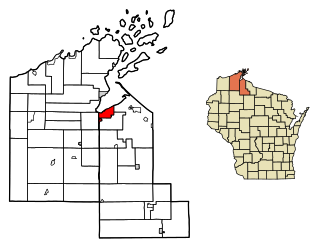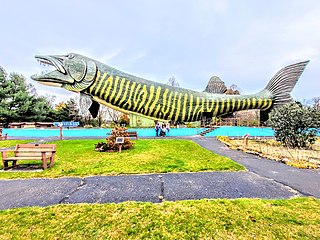
The St. Croix River is a tributary of the Mississippi River, approximately 169 miles (272 km) long, in the U.S. states of Wisconsin and Minnesota. The lower 125 miles (201 km) of the river form the border between Wisconsin and Minnesota. The river is a National Scenic Riverway under the protection of the National Park Service. A hydroelectric plant at the Saint Croix Falls Dam supplies power to the Minneapolis–St. Paul metropolitan area.

Ashland is a city in Ashland and Bayfield counties in the U.S. state of Wisconsin. It is the county seat of Ashland County. The city is a port on Lake Superior, near the head of Chequamegon Bay. The population was 7,908 at the 2020 census, all of whom resided in the Ashland County portion of the city. The unpopulated Bayfield County portion is in the city's southwest, bordered by the easternmost part of the Town of Eileen.

Hayward is a city in Sawyer County, Wisconsin, United States, next to the Namekagon River. Its population was 2,318 at the 2010 census. It is the county seat of Sawyer County. The city is surrounded by the Town of Hayward. The City of Hayward was formally organized in 1883.

Angelus Oaks is an unincorporated community in San Bernardino County, California, United States, and has a population of 535 as of the 2010 U.S. Census, up from an estimated population of 312 in 2000. It is surrounded by the San Bernardino National Forest and located east of San Bernardino on California State Route 38.
Lac Courte Oreilles is a large freshwater lake located in northwest Wisconsin in Sawyer County in townships 39 and 40 north, ranges 8 and 9 west. It is irregular in shape, having numerous peninsulas and bays, and is approximately six miles long in a southwest to northeast direction and with a maximum width of about two miles (3 km). Lac Courte Oreilles is 5,039 acres (20.39 km2) in size with a maximum depth of 90 feet (27 m) and a shoreline of 25.4 miles (40.9 km). The lake has a small inlet stream that enters on the northeast shore of the lake and flows from Grindstone Lake, a short distance away to the north. An outlet on the southeast shore of the lake leads through a very short passage to Little Lac Courte Oreilles, then via the Couderay River to the Chippewa River, and ultimately to the Mississippi River at Lake Pepin.

The Black Moshannon State Park Historic Districts are three separate historic districts on the National Register of Historic Places (NRHP) at Black Moshannon State Park in Rush Township, Centre County, Pennsylvania in the United States. The structures in the historic districts were constructed in the 1930s during the Great Depression by the Civilian Conservation Corps (CCC). The three districts are: the Beach and Day Use District, with 18 contributing structures, including 11 different picnic pavilions, concession building, bathhouse, museum, and four open pit latrines; the Family Cabin District with 16 contributing properties, including 13 cabins, one lodge and two latrines; and the Maintenance District with four contributing properties, including a storage building, three-bay garage, gas pump house, and ranger's residence.

Copper Falls State Park is a 3,068-acre (1,242 ha) state park in Wisconsin. The park contains a section of the Bad River and its tributary the Tylers Forks, which flow through a gorge and drop over several waterfalls. Old Copper Culture Indians and later European settlers mined copper in the area. The state park was created in 1929 and amenities were developed by the Civilian Conservation Corps and the Works Progress Administration. In 2005 the park was listed on the National Register of Historic Places as a site with 10 contributing properties.
The Redick Lodge, also known as the Chambers Lodge, is a private seasonal retreat on Upper Fremont Lake near Pinedale, Wyoming in the Wind River Range at an elevation of 7,500 feet (2,300 m). The lodge was designed by architect Otis Miller of Miles City, Montana as a log cabin on a stone foundation for George M. Redick, a Nebraskan who had worked with the Union Pacific Railroad on potential locations for company hotels. The Redick family spent summers at the lodge from 1918 through 1931, when family fortunes declined. The property was purchased by Dr. Oliver Chambers of Rock Springs, Wyoming in 1938 and has remained in the Chambers family.
Windigo Lake is a freshwater lake located in north central Wisconsin in the Town of Bass Lake, Sawyer County, United States, in township 40 north, range 9 west. The lake is irregular in shape, with numerous peninsulas and bays, and is approximately one mile in diameter. Windigo Lake is 529.6 acres (2.143 km2) in size with a maximum depth of 51 feet (16 m) and a shoreline of 9 miles (14 km). The lake does not have an obvious inflow or outflow stream and is classified as a seepage lake, i.e., a lake without an inlet or an outlet.
The Bay-Lakes Council is the Boy Scouts of America (BSA) council serving eastern Wisconsin and the Upper Peninsula of Michigan. Headquartered in Appleton, Wisconsin, it is geographically one of the largest local BSA councils. Bay-Lakes Council #635 was formed on July 1, 1973, the product of a merger between six east Wisconsin councils. The council is served by Kon Wapos Lodge #635 of the Order of the Arrow.

The Mondeaux Dam Recreation Area is a public park in the forest in the town of Westboro, Wisconsin, United States. The Civilian Conservation Corps (CCC) and Work Projects Administration (WPA) created the lake and facilities during the Great Depression.
The W. D. Boyce Council of the Boy Scouts of America serves youth in central Illinois, from Lincoln to Ottawa, and Peoria to Bloomington.

Mary Griggs Burke was an American art collector. Over fifty years, Burke acquired the largest private collection of Japanese art outside Japan. Her collection grew so large that she housed it in a separate apartment adjacent to her own on the Upper East Side of Manhattan. In 1985, portions of her collection were exhibited at the Tokyo National Museum, becoming the first Western collection of Japanese art to be displayed at the museum. Mary Griggs Burke was a Trustee, (1976-1995) and Trustee Emeritus (1995-2012) to The Metropolitan Museum of Art. She also inherited Forest Lodge, a family lake-side property on Lake Namakagon near Cable, Wisconsin which she loved dearly; that property was left to Northland College in Ashland, Wisconsin, along with a $10-million endowment to create the Mary Griggs Burke Center for Freshwater Innovation.

Parmachenee Lake is on the Magalloway River near the Canadian border on the western edge of Maine. The lake was named for the daughter of Native American chief Metalluk, and is best known for the Gilded Age Parmachenee Club. The Magalloway River headwaters enter the north end of the lake in Parmachenee township, and the lake extends south into Lynchtown township where it overflows 2 miles (3.2 km) upstream of Aziscohos Reservoir.
The Brooks Lake Lodge, also known as the Brooks Lake Hotel and Diamond G Ranch, as well as the Two-Gwo-Tee Inn, is a recreational retreat in Fremont County, Wyoming near Dubois in the upper Wind River valley. The complex was built in 1922 to accommodate travelers coming to Yellowstone National Park on U.S. Route 287 from central Wyoming. The buildings are mainly of log construction with Craftsman style detailing.

The Cross River Heritage Center is a museum in Schroeder, Minnesota, United States. Operated by the Schroeder Area Historical Society, it collects and interprets the history of the local area and the greater North Shore of Lake Superior. The center opened in 2002 in a Tudor Revival building constructed in 1929 as the Stickney Inn and Store. The building is located on the south side of Minnesota State Highway 61 near the west bank of the Cross River.

Lake Namakagon is located in Bayfield County, Wisconsin. The lake is a large freshwater drainage lake that opens inlet and outlet of streams located between Lake Superior and Mississippi River system. The lake is located in the upper Namekagon river watershed as St. Croix river basin is the subwatershed of it. The lake derives its name from the Ojibwe language, and it means "Lake abundant with sturgeons." It is known for tourism and was the home of the legendary Anishinaabe Chief Namakagon.

Robert C. Pringle, originally named Chequamegon, was a wooden-hulled American tugboat that sank without loss of life on Lake Michigan, near Sheboygan, Wisconsin, on June 19, 1922, after striking an obstruction.























